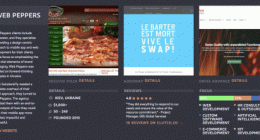The present-day world of web development and design is extremely competitive and tough. So, before you dive into it headfirst, you must consider a number of issues you may face. Starting out without a road map is like walking around a dark room. You can stumble upon something and fall, injuring yourself badly. You need to get organized and determine the right direction for your company to move in if you want to avoid failure. The best way to do that is to create a web development business plan. While it may seem a daunting task, at first sight, it’s actually simpler than you think. You just need to go over some basic points we’ve described below.
If you’ve already tried your hand at making a plan for your web design and development startup, you can compare it against our list to ensure you’ve included all the essentials.
Web Development Business Plan Main Points
Here are the principal considerations you need to take into account when writing a web development business plan – in this precise order.
1. Identify Your Future Customers
Decide what kind of people your startup is going to focus on in the first place. Finding the right niche is of utmost importance for any business. When trying to please everyone, you may end up having no customers at all.
Instead of saying that you’re going to build universal applications, narrow down your proposition to just a specific industry (e.g., healthcare, construction, or oil and gas extraction) or type of business (e.g., large enterprises or individual entrepreneurs).
To help you come up with ideas, consider this checklist:
- You know who will have enough money to purchase what you can offer
- You know where your customers normally search for what they need (e.g., social media, television, word-of-mouth, etc.)
- You know how you can get connected to your customers
- You know (or can predict) specific details about your potential customers (how old most of them are; what most of them do for a living; how much they earn on average; whether they are mostly men or mostly women; where the majority of them lives; how well-educated they are);
2. Find Out Everything About Other Companies in Your Niche
Devote the next stage of your web development business plan to the research on other firms engaged in web design and development in the market segment you’ve identified as your main target.
As Jonathan Swift famously said, “One enemy can do more hurt than ten friends can do good.” Other businesses in your niche will be trying to snatch your bread and butter away from you. So, you need to know them inside and out to be better prepared for the fight.
Google the names of your rivals and make a list. Then do research on them, paying particular attention to these points:
- What customers say about them on the Internet. What positive aspects of their businesses do they mention? What critical comments do they leave?
- How exactly do your rivals charge their customers? What payment plans have they put in place?
- What is their assortment of products or services?
Knowing what your competition is good or bad at, you can shape your own pricing policy, avoid the same mistakes they’ve made, and come up with unique offerings to stand out from the crowd. You may find this guide on competition analysis useful.
3. Find the Right People for the Job
No web development business plan will be complete without a description of requirements for the software professionals you’re going to take on board your web design and development startup ship.
The job market these days is awash with developers of all levels of expertise: from junior and middle to senior. However, possessing the necessary skills or degrees is just one part of the equation. Even the most brilliant programmer may turn out to be completely incompatible with your corporate culture.
So, when looking for the staff for your startup, do the following:
- Note down the most important requirements for your future employees.
- Prepare a list of technical questions to ask the candidates.
- Find out what the previous employers say about the candidates.
- Review the candidates’ previous practical experience and backgrounds.
We also highly advise you to talk to your potential workers via Skype first. That will enable you to shortlist the most suitable specialists for a face-to-face interview. Read this post for a better insight into the matter.
4. Find Customers
The range of options for finding customers these days is quite wide. For example, you can sign up for specialized resources where customers looking for web development expertise can get in touch with software professionals who provide it. The list includes the likes of Upwork, Freelancer, and others.
You can also try the time-tested, old-fashioned customer-hunting method: literally knocking on office doors in your local area and asking entrepreneurs if they need your web development services. Additionally, visit business/webmaster forums – it’s well worth it.
5. Manage Your Finances Wisely
This is probably the most crucial part of a web development business plan. After all, it’s the money any company is after, web design and development startups included. A business that spends more than it makes is bound to be short-lived.
Bottom Line
The success or failure of a web design and development startup to a great extent depends on a carefully designed web development business plan. While there can be other important aspects to consider, start with the essential steps we’ve outlined in this post.
Understand who your potential customers are, research your competition, find the right professionals to do the work, advertise your company, be prudent with your money – and your chances to survive and thrive will increase.









